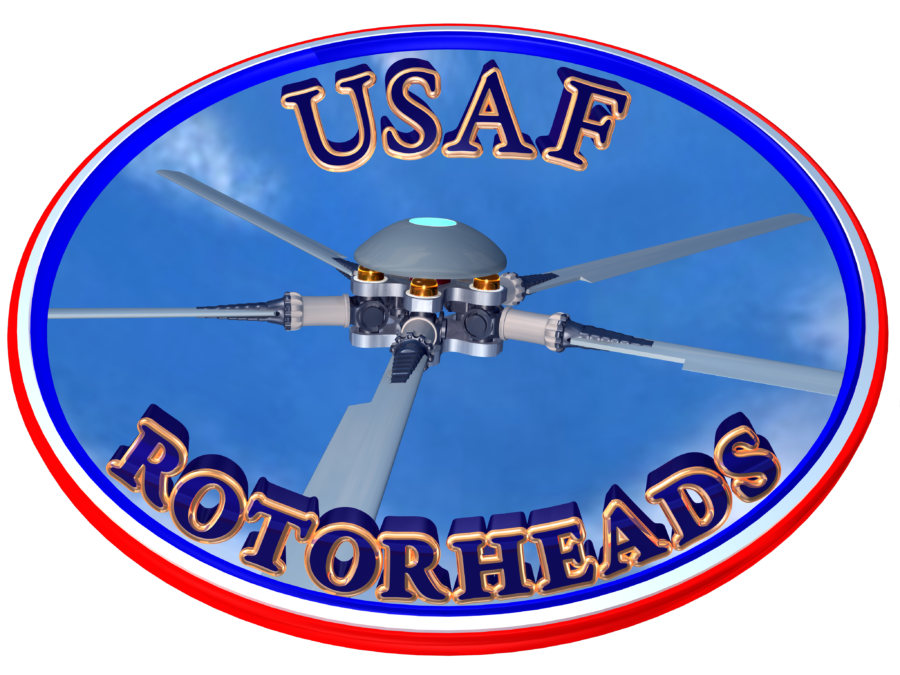Tributes
USAF RotorHeads honors all that maintained or flew U.S. Air Force helicopters.
"Congratulations to all and thank you for a job well done!"
We are proud of the service you unselfishly provided to our great country -- The United States of America



“HATS OFF TO THE MAINTENANCE GUYS”
There are some very special individuals who arrive at work early and depart late in the evening, often times not leaving until their aircraft is flight ready. These individuals are the “maintenance” folks that are dedicated to providing a safe aircraft for the flight crew. This cadre of people consists of a group of maintainers that provide outstanding support to the crew chief. The maintenance folks arrive at their respective duty station many hours before the aircraft is scheduled to fly. Preparing the aircraft for flight often times happens under less than favorable conditions, such as darkness, weather, etc.
It is the maintenance folks that "fix" the aircraft and give it to the flight crew to "break". In a combat environment it is highly likely for aircraft to return with more than just maintenance problems. Long after the flight crew has departed these dedicated individuals are busy readying the next day’s flyers. There are times when the flight crew returns the next day and find the maintenance folks still working.
The plight of the maintenance person is often a thankless job. However this fine group of folks are dedicated to their work and realize the single most important thing is to provide a safe and reliable aircraft. When maintenance informs operations a bird is ready for flight it is ready for flight and down to the last man the maintenance guy will willingly get on the aircraft and fly with the flight crew.
Traditionally the maintenance crews have an excellent relationship with the flight crew. When the flight crew is preparing for a flight, it is the maintenance person who is there to provide any assistance or answer any questions the flight crew has about the aircraft. These guys deserve as much credit for mission accomplishments as anyone and often accomplish their job without the recognition they deserve.
REMEMBER THE FORGOTTEN MECHANIC
Through the history of world aviation, many names have come to fore,
Great deeds of the past in our history will last, as they're joined by more.
When men first started his labor in his quest to conquer the sky,
He was designer, mechanic, and pilot; and he built a machine that could fly.
But somehow the order got twisted, and then in the public's eye,
The only man that could be seen was the man who knew how to fly.
The pilot was everyone's hero, he was brave, he was bold, he was grand,
And he stood by his battered old biplane with his goggles and helmet in hand.
To be sure, these pilots have earned it - to fly you have to have guts.
And they have blazed their names in the hall of fame on wings with bailing wire struts.
But for each of these flying heros, there are thousands of little renown.
And these are the men who worked on the planes, but kept their feet on the ground.
We all know the name Lindberg, and we have read of his flight into fame.
But think, if you can of his maintenance man - Can you remember his name?
And think of our wartime heros, Young, Zender and Scott!
Can you tell me the names of their crew chiefs? A thousand to one you cannot!
Now pilots are highly trained people and wings are not easily won;
But without the work of the maintenance man, our pilot would march with a gun.
So when you see the mighty Jolly Green Giants as they work their way thru the air,
The grease stained man with a wrench in his hand is the man who put him there.
-Anonymous
Provided by Joe Ballinger
Note: This applies to all Crew Chief types, not just the Jolly Greens.



“HELICOPTER FLIGHT MECHANICS AND FLIGHT ENGINEERS”
The glamorous life of the helicopter Flight Engineer or Flight Mechanic is not always so glamorous.
The Flight Mechanic performs all the same tasks as a maintenance person and when the aircraft launches he becomes an integral part of the flight crew and assumes the tasks of the Flight Engineer. These are the guys that have to repair any problems or damage the aircraft returns with and have it ready to fly the next day, as well as be ready to fly himself often times missing meals and with little or no rest.
The role of the Flight Mechanic is truly a double duty role, both maintenance and in-flight duties. He has no one to blame when he brings an aircraft home broken or damaged.
There are those that believe that the Flight Engineer is an unnecessary evil. He is the person that returns with the broken or damaged aircraft and departs leaving the maintenance guys with the arduous task of getting the bird ready for the next flight.
To the folks that are unknowledgeable about the in-flight duties of the Flight Engineer they may not realize that while in the air he is the third set of eyes for the pilots. He is also responsible for monitoring cockpit readings and is ready to alert the pilot of out of range conditions on the engines, rotor system, etc.
On those aircraft having in-flight refueling capabilities the Flight Engineer has numerous procedures that he must be knowledgeable about in order to assist the pilots as necessary during the refueling operation. Depending on the flight crew the Flight Engineer would operate the refueling panel and extend the probe, control the amount of fuel going to each tank, and then retract the probe.
In combat situations the Flight Engineer becomes an extremely vital member of the crew while performing his duties as a gunner, hoist operator, and giving the pilot vital information while in a hover during a rescue operation. While all this is going on he needs to be cognizant of where the aircraft is in relation to the survivor, trees or other objects that could cause severe damage to the aircraft if not avoided. Additionally the Flight Engineer is constantly observant for enemy ground fire.
Both the Flight Mechanic and the Flight Engineer are always prepared for the unexpected and able to react in a timely fashion.



“HELICOPTER PILOTS”
Helicopter Pilots are often referred to the "Guys In Front" (GIF). These daring souls seem to always have both hands and both feet moving while controlling the helicopter at the same time listening to the various radios, changing frequencies, watching the weather and keeping an eye on all the cockpit gauges. If this alone isn't enough, put him at the controls on a dark rainy night out over some ship or over the trees of some jungle holding the helicopter in a hover while attempting to accomplish a hoist pickup. Now, in addition to all the aforementioned actions he now must rely on the directions he receives from the "Guy In Back" (GIB), as the pickup is accomplished, in order to maintain a steady hover or providing guidance to avoid trees or other obstacles that may damage the helicopter and affect its ability to perform properly. He is constantly concerned with keeping the helicopter within prescribe operating limitations to ensure it will accomplish the job. He is able to make critical decisions in a short period of time to determine hover capabilities and fuel remaining in order to effectively and safely accomplish the mission. After some time this all becomes pretty much routine and second nature in the life of a "chopper pilot".
Having said that now he finds himself in one of those tricky situations where he may be able to land with only one gear or skid on the side of a cliff or the top of some rock in order to accomplish the mission. Then throw into the picture the "bad guys" on the ground that are attempting to foil the rescue attempt by any means which usually means all sorts of ground fire to include automatic weapons and often mortars being lobbed into the landing zone (LZ).
These brave souls, sitting in plain view of the bad guys with only some plexi-glass between them and the outside. They always managed to maintain their presence and concentrate on getting the job done.
These same pilots may find themselves hovering over a crashed and burning aircraft, hovering extremely close to the fire. This action is a delicate one at best as the pilot must keep his aircraft in a position that the rotor wash will fan the flames back allowing the ground rescue crew effect a safe recovery. While all this is going on he is monitoring cockpit gauges, the outside area and also having in mind that the aircraft may be carrying explosive ordnance that may blow at anytime.
Air Force Helicopter pilots are without a doubt some of the greatest folks one would ever want to know. They are dedicated, hard working and have that "Git-R-Done" attitude. A proud and professional group of individuals.
 "THAT OTHERS MAY LIVE"
"THAT OTHERS MAY LIVE" 
Fire Fighters were assigned to the HH-43B ARRS units as an integral part of the crew that responded to aircraft emergencies. When the Klaxon sounded the crews scrambled and were in their aircraft and airborne, usually within a minute, with the Fire Suppression Kit (FSK) slung underneath the helicopter. The HH-43B was normally the first to arrive at a crash site and would assess the situation taking all precautions with safety of all concerned at the forefront.
The Fire Fighter is the guy who went into the fire when most others were running away from it. They never knew what to expect, as each mission was different. There was always the concern for on board ordnance on the downed aircraft exploding or the aircraft itself exploding as a result of a fire.
Wearing fire proof suits and dragging a hose from the FSK the Fire Fighter entered the flames of the crashed and burning aircraft. The hovering HH-43B’s rotor wash would suppress the flames providing the Fire Fighter with a path to rescue the crewmembers of the crashed aircraft.
It was with great pride that these individuals would jeopardize their own life in an attempt to save another life. The HH-43B Fire Fighter was never given the appropriate recognition deserved for their selfless efforts to save a downed aircrew.
Integrity, Honor, and Respect
Some of the best things cannot be bought, they must be earned
©2023 USAF Rotorheads All Rights Reserved | Financial Statement

